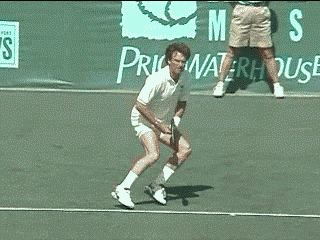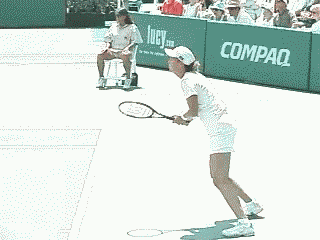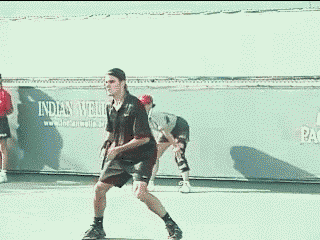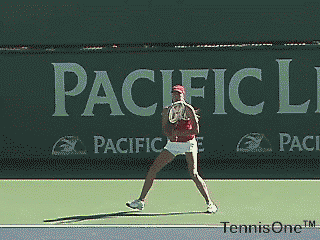|
TennisOne Lessons Four Topspin Forehands Doug Eng EdD, PhD If you have taken lessons on the forehand side, you may have been taught to make a perfect C-shaped swing: low to high over the shoulders with waist-high contact. At times you might have varied it and found yourself corrected by your teaching pro or even by yourself with that self talk we all do when executing a less than perfect stroke. You might have thought a great practice was using a ball machine and trying to reproduce an identical swing one hundred times in a row. I see many club players use the same swing when warming up at the service line (in a mini-tennis warm-up), at the baseline, or when pulled wide off the court. One student of mine used to take this swing ten feet or fifty feet away from the net – which many players actually do. Since she was a golfer, I’d ask her, would she take a driver out on the putting green, or in the sand bunker, or in the rough? It took a while but she eventually made some adjustments. Just like you have a short volley swing at the net and a full swing on your baseline forehand, you can have a number of different forehand swings. And I don’t mean you have a volley, a groundstroke, and a half-volley, but rather four distinct ways of producing topspin. Table 1 shows a breakdown of the four topspins, their characteristics, and when you want to use them.
Now that we have an idea of the four forehands you want to have (or already may have), let’s take a closer look at the mechanics and tactics.
Classic Drive The classic swing is a C-motion, low to high with an over-the-shoulder finish. This stroke is most often taught as the basic forehand. It produces moderate topspin and a good amount of power. Today, the classic drive is just one of several techniques. Thirty years ago, this stroke was dominant as touring pros didn’t use heavy topspin since the racquets were smaller and heavier and the strings less compliant. Jimmy Connors hit a fairly flat forehand using classic technique. In the video he had time to set up well in a square stance for a powerful drive. Back in the day, his smaller, heavier T2000 racquet required a flatter stroke to make solid contact. Note how the racquet stays down longer in the contact zone. Pros often use this swing when they are slightly behind the baseline and well-balanced. Again, we see Jimmy Connors is not under pressure as he sets up. The ball is usually in the wheelhouse, meaning it is in the ideal striking zone, between the the knees and the waist. You can be very aggressive with this swing and hit out on the ball. In the next video, we see Lindsay Davenport using this same classic drive as she also has time to set up from the center of the baseline. High to High Forehand The most offensive, aggressive shots in tennis are hit above the waist. This would include the serve, the overhead, the high volley, and the swinging volley. Often we think of being at the net as an attacking situation, but that is true when the ball is comfortably high. In general, your offensive chances increase as you get closer to the net, provided the ball is reasonably high. The high-to-high swing is used on the swinging volley or when you take the shoulder-high ball on the rise after the bounce. The noted coach Brett Hobden coined this as the “dip drive” which refers to the high ball being driven down using a high to high swing path.
Years ago, this technique was rarely used since it was believed that taking the ball well above the height of the belly button was not an ideal contact point. But today, with the heavily spun balls that jump up even at the club level, it becomes necessary to play this shot. Today’s lighter racquets are quite maneuverable allowing you to attack at shoulder-height. Thus, we see many touring pros and good juniors making contact well above the waist. Keep in mind it is easier to use the body and legs if the contact point is waist high or slightly below. Higher balls require greater shoulder and core strength and use less legs. For most of us, it is more comfortable to make contact at the waist or below, but if you are willing to trade your comfort level for more attacking chances you should consider using the high-to-high swing. You might make a few more errors, but you will hit even more winners. Fernando Gonzalez is one of the biggest hitters in tennis today. In the video above, we see a high-to-high swing even from behind the baseline as his opponent tries to force him back with a deep heavy ball. On the high-to-high swing, the swing plane is entirely above the waist. That means power must be generated from the shoulder spin. Note Gonzalez uses his legs to elevate and spin up into the ball. His shoulders and legs spin around showing great angular momentum.
A common tactic in the modern game is running around the backhand and ripping a forehand. In the video, we can see Roger Federer run around his backhand and use a high-to-high swing to attack the ball. Too often in this situation, club players use low-to-high swings to attack the high ball (or just as bad, let the ball drop below waist height). This results in a heavily spun ball that doesn’t penetrate the court. Remember when you practice this shot, keep the racquet swing above the waist through out the stroke. On your backswing, set the hand high at shoulder height and cock the wrist so the racquet head stays up. Some players like to simply take the backswing on a higher plane. Then they use the high-to-high swing with an elevated C shaped racquet path. Windshield Wiper or Inverted Forehand Three decades ago, the Swedes were teaching a technique made famous by the legendary Bjorn Borg. Today’s western style grips tend to promote the rotation of the arm across the body. As the racquet hand crosses in front of the body, the racquet head moves across the body like a windshield wiper to finish with the racquet hand near the opposite elbow. As the hand reaches the opposite elbow, the racquet head tends to end in a slightly downward position rather than an upward position as when the finish is over the shoulders. This downward finish is also called the inverted finish and is a consequence of the increased topspin and sliding the hand towards a more western grip. That is, the more you move your hand from a continental to a western grip, the more topspin and windshield wiper effect you are likely to get.
Roger Federer makes effective use of this swing as we see in his video. He steps inside the baseline and uses the inverted finish which is a consequence of his attempt to drive the ball with a bit of extra spin on this aggressive shot. Sometimes we see a relaxation of the wrist as it breaks slightly after contact. This wrist flexion is a sign of great acceleration similar to what happens on the serve. The windshield wiper allows for increased topspin on aggressive shots. It can be played on passing shots and aggressive low and high balls inside the baseline where overhitting can present a problem. It can even be played on the half-volley. For practice, stand inside the baseline and use a shortened backswing as you attempt this technique. You will find the shortened swing and the extra topspin will help keep the ball in the court. Make sure you get good racquet head speed to keep the spin tight. Buggy Whip or Reverse Forehand The term “buggy whip” (from what I know) was coined by the great coach, Dennis van der Meer. It has been around for years and I first wrote about it nearly fifteen years ago. The newer term “reverse finish” refers to the same motion and was made famous by Rafael Nadal, Gustavo Kuerten, and some well-known students of coach Robert Lansdorp, Pete Sampras, Lindsay Davenport, and more recently, Maria Sharapova. Ironically, Lansdorp admits not teaching this stroke. In fact, he first discouraged its use. But he soon saw the merit in it and now teaches the technique as a necessary part of a high level game.
Their style limited the use of heavy topspin. However, in any advanced game, there are heavy topspin situations. For example, when your opponent rips a ball at your feet and you need to neutralize the pace. Or when you are pulled wide and need to gain time by playing a high arcing ball. At times when Maria couldn’t hit out on the ball, she needed to create more topspin. So she had to go more upwards with the racquet. Looking at Maria’s video, we see that, in addition to increased topspin, the compact swing allows great balance and recovery. If she swings any bigger, she loses a step back into the court or overhits her forehand. Rafael Nadal developed the buggy whip into an offensive shot. By applying a tremendous amount of spin he creates a ball that gives opponents plenty of problems. Needless to say, Nadal also plays this shot in defensive situations. Nadal rarely misses as the topspin always pulls the ball back into the court. Note in his video, he actually swings forward and then upwards rather than straight up. When many club players try the buggy whip, they tend to go straight up rather than through the ball and then up. Practicing the Reverse Forehand Here’s a great practice idea. Have a friend feed you a slightly wide ball so that you have to move to it. Jog to the ball and try using the reverse swing. If you execute the swing correctly, you should finish on the dominant side of your body and your dominant hand will either touch the top of your head or allow your racquet touch your back. You should also practice this with your friend tossing you a ball short in the court. By using this technique on a short ball, you are less likely to overhit and you can arc the ball over the net bringing it down safely inside the court. A final use for the reverse is the topspin lob. Practice lobbing to an imaginary target ten to fifteen feet over the net.
To use the reverse effectively, the contact point should not be too high. One might guess that because of the vertical swing path. This shot is best used with balls at the waist level or below. That allows the legs to drive upwards and create heavy spin. High balls are more difficult to drive and require a high-to-high swing as discussed earlier. Some pros and sport scientists suggest that the reverse may lead to shoulder impingement. When you raise your arm, the bones in your shoulder joint may squeeze tightly since there is little space for this type of upwards shoulder movement. So far, I haven't seen many injuries. My suggestion is that you raise your elbow no more than 10-20 degrees above the shoulder line. Putting It All Together In a typical rally, every ball is slightly different. That doesn’t mean you use radically different techniques to hit the ball. You must use your footwork to strive for the best possible striking position on every shot. Nevertheless, each ball comes at you with different velocity, spin, and height. Like Dinara Safina on her rally shown here, we must consider using variations of topspin forehands to attack, defend, or neutralize our opponents. Dinara uses a couple of classic swings, then a reverse on the wide ball to regain position, before finally playing an inverted swing to neutralize her opponent. Note how she does not need to move much on the first two balls. That allows her to attack the ball with pace using a classic topspin drive (with the over-the-shoulder finish). On her third shot, she runs wide and uses a reverse to recover well and impart a bit of extra spin to defend and stay in the rally. On her fourth and last shot, Dinara uses an inverted swing to impart a little extra spin and height. You might say she just rolled this last shot in.
Although you might try to practice a perfect topspin drive, do take note that there are many topspin forehand variations which you should incorporate. The variations are tactical and positional. They depend on your court position and the height and speed of the ball. It may be true you prefer one particular technique more than others but develop the ability to use all four appropriately. In addition, there are other types of forehands you could hit such as a slice. Practice using these techniques and you will develop a greater variety to your game as well as better tactical and court sense. Your comments are welcome. Let us know what you think about Doug Eng's article by emailing us here at TennisOne.
Doug Eng EdD PhD coaches men's tennis at Tufts University. During the summer, he directs at the Tennis Camps at Harvard. He has received divisional Pro of the Year honors from the PTR and USPTA and several national award. Doug completed the USTA High Performance Coaches program and frequently runs educational and training programs for coaches. Doug also writes and speaks on tennis and sport science. |
|||||||||||||||||||||||||||||||||





